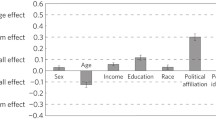Abstract
A modification of the Osgood-Tannenbaum sociopsychological model of belief change is applied to University of Cincinnati student perceptions of Southwest Ohio and of the Kentucky Bluegrass. Students scale their beliefs about the two regions; after a week, they are given a factual presentation associating the two regions and asked to again scale their beliefs. The variable which proves most important in the resultant belief changes for the Kentucky Bluegrass is the separation of the two regions on a student's initial belief scale, suggesting the willingness of the students to believe the new information. Further analysis indicates that although objective differences in the regions affect initial beliefs, they play a negligible role in the degree to which students change their beliefs. A “halo effect” is also discovered, in which beliefs not mentioned in the presentation change in predictable directions. The empirical results appear encouraging to recent efforts which have been made to change popular impressions about places.
Similar content being viewed by others
References
Anderson, N. H. “Averagingvs. Adding as a Stimulus-Combination Rule in Impression Formation,”Journal of Experimental Psychology, 70 (1965): 394–400.
Fishbein, M. “An Investigation of the Relationships between Beliefs about an Object and the Attitude toward that Object,”Human Relations 16 (1963): 233–240.
Fishbein, M., ed.Readings in Attitude Theory and Measurement. New York: John Wiley, 1967.
Fishbein, M. and I. Ajzen.Belief, Attitude, Intention, and Behavior: An Introduction to Theory and Research. Reading, Mass.: Addison-Wesley, 1975.
Fishbein, M. and B. H. Raven. “The A-B Scales: An Operational Definition of Belief and Attitude,”Human Relations, 15 (1962): 35–44.
Gould, P. “Acquiring Spatial Information,”Economic Geography, 51 (1975): 87–99.
Harris, A., A. Patterson, and R. White. “Images of America,” unpublished manuscript, Departments of Geography and Psychology, Northwestern University, 1970.
Infante, D. A. “Differential Functions of Desirable and Undesirable Consequences in Predicting Attitude and Attitude Change Toward Proposals,”Speech Monographs, 42 (1975): 15–134.
Infante, D. A. “The Perceived Importance of Cognitive Structure Components: An Adaptation of Fishbein's Theory,”Speech Monographs, 40 (1973): 8–16.
Jones, R. C. “Myth Maps and Migration in Venezuela,”Economic Geography, Vol. 54 (1978): 75–91.
Jones, R. C., and G. Zannaras. “The Decline of Urban Primacy in Latin America: General Trends and a Venezuelan Case Study,” unpublished manuscript, Summer, 1980.
Kiesler, C., B. Collins, and N. Miller.Attitude Change: A Critical Analysis of Theoretical Approaches. New York: John Wiley, 1969.
Lieber, S. R. “A Joint Space Analysis of Preferences and Their Underlying Traits,” Discussion Paper No. 19, Department of Geography, University of Iowa, Iowa City, Iowa, 1971.
Lloyd, Robert E. “Cognitions, Preference, and Behavior in Space: An Examination of the Structural Linkages,”Economic Geography, Vol. 52 (1976): 241–253.
Mazey, M. E.An Analysis of Urban Activity Systems: The Case of Newport, Kentucky, Unpublished Ph.D. dissertation, Department of Geography, University of Cincinnati, Cincinnati, Ohio, 1977.
McGuire, W. J. “A Syllogistic Analysis of Cognitive Relationships,” in C. I. Hovland and M. J. Rosenberg (eds.),Attitude Organization and Change, New Haven: Yale University Press, 1960, pp. 65–111.
McGuire, W. J. “Inducing Resistance to Persuasion: Some Contemporary Approaches,” in L. Berkowitz (ed.),Advances in Experimental and Social Psychology. New York: Academic Press, 1964, pp. 191–229.
McGuire, W. J. “The Current Status of Cognitive Consistency Theories,” in S. Feldman (ed.),Cognitive Consistency: Motivational Antecedents and Behavioral Consequences. New York: Academic Press, 1966.
Osgood, C. E. and P. H. Tannenbaum. “The Principle of Congruity in the Prediction of Attitude Change,”Psychological Review, 62 (1955): 42–55.
Tannenbaum, P. “The Congruity Principle Re-Visited: Studies in the Reduction, Induction, and Generalization of Persuasion,” in L. Berkowitz, (ed.),Advances in Experimental Social Psychology, New York: Academic Press, 1967: 270–320.
Triandis, H. C. and M. Fishbein. “Cognitive Interaction in Person Perception,”Journal of Abnormal and Social Psychology, 67 (1963): 446–453.
Urell, J.Residential Mobility Among Renter Households: Cincinnati, Ohio. Unpublished Ph.D. dissertation, Department of Geography, University of Cincinnati, Cincinnati, Ohio, 1976.
Zimmer, D.The Industrialization of the Bluegrass Region of Kentucky, Unpublished Ph.D. dissertation, Department of Geography, University of Kentucky, Lexington, Kentucky, 1969.
Author information
Authors and Affiliations
Rights and permissions
About this article
Cite this article
Jones, R.C., Zannaras, G. Belief change and its determinants in a regional setting. Ann Reg Sci 16, 37–50 (1982). https://doi.org/10.1007/BF01287405
Received:
Revised:
Issue Date:
DOI: https://doi.org/10.1007/BF01287405




